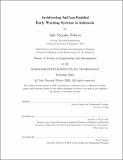| dc.contributor.advisor | Danielle R. Wood. | |
| dc.contributor.author | Nikicio, Ajie Nayaka. | en_US |
| dc.contributor.other | Massachusetts Institute of Technology. Engineering and Management Program. | en_US |
| dc.contributor.other | System Design and Management Program. | en_US |
| dc.coverage.spatial | a-io--- | en_US |
| dc.date.accessioned | 2021-10-08T17:10:39Z | |
| dc.date.available | 2021-10-08T17:10:39Z | |
| dc.date.copyright | 2020 | en_US |
| dc.date.issued | 2021 | en_US |
| dc.identifier.uri | https://hdl.handle.net/1721.1/132889 | |
| dc.description | Thesis: S.M. in Engineering and Management, Massachusetts Institute of Technology, System Design and Management Program, February, 2021 | en_US |
| dc.description | Cataloged from the official version of thesis. "February 2021." | en_US |
| dc.description | Includes bibliographical references (pages 96-110). | en_US |
| dc.description.abstract | Indonesia lies within the Ring of Fire, making the country highly prone to geophysical disasters such as earthquakes and tsunamis, in addition to weather-related disasters such as floods, landslides, and wildfires. One effective way to reduce the risk of getting hit by these natural disaster hazards is through the deployment and operation of early warning systems. Early warning systems are generally responsible for two things: identifying the hazard precursors and delivering the warning in a timely manner. In both of these functions, wireless communication plays a critical role. Terrestrial communication, however, is often compromised when a disaster hits. Satellite communication (SatCom) offers a promising alternative not only for warning transmission, but also precursor detection from the thousands of disaster monitoring sensors deployed. It enables the placement of such sensors in remote areas, often closer to the source of the hazards. This thesis uses system architecture concepts to evaluate the pros and cons of the various terrestrial and satellite communication technologies in the context of early warning systems and suggest the best architecture for each use case. Based on the results of the analysis, satellite L-band, S-band, amateur radio, and newer technologies such as satellite LPWAN and GSM can provide significant benefits in terms of performance and cost. Additionally, the benefit of combining technical development and community engagement are highlighted for a sustainable early warning system. Findings from this thesis are hoped to provide the relevant government agencies in Indonesia and other countries with similar challenges for disaster risk reduction. | en_US |
| dc.description.statementofresponsibility | by Ajie Nayaka Nikicio. | en_US |
| dc.format.extent | 110 pages | en_US |
| dc.language.iso | eng | en_US |
| dc.publisher | Massachusetts Institute of Technology | en_US |
| dc.rights | MIT theses may be protected by copyright. Please reuse MIT thesis content according to the MIT Libraries Permissions Policy, which is available through the URL provided. | en_US |
| dc.rights.uri | http://dspace.mit.edu/handle/1721.1/7582 | en_US |
| dc.subject | Engineering and Management Program. | en_US |
| dc.subject | System Design and Management Program. | en_US |
| dc.title | Architecting SatCom-Enabled Early Warning Systems in Indonesia | en_US |
| dc.type | Thesis | en_US |
| dc.description.degree | S.M. in Engineering and Management | en_US |
| dc.contributor.department | Massachusetts Institute of Technology. Engineering and Management Program | en_US |
| dc.identifier.oclc | 1263357531 | en_US |
| dc.description.collection | S.M.inEngineeringandManagement Massachusetts Institute of Technology, System Design and Management Program | en_US |
| dspace.imported | 2021-10-08T17:10:39Z | en_US |
| mit.thesis.degree | Master | en_US |
| mit.thesis.department | SysDes | en_US |
